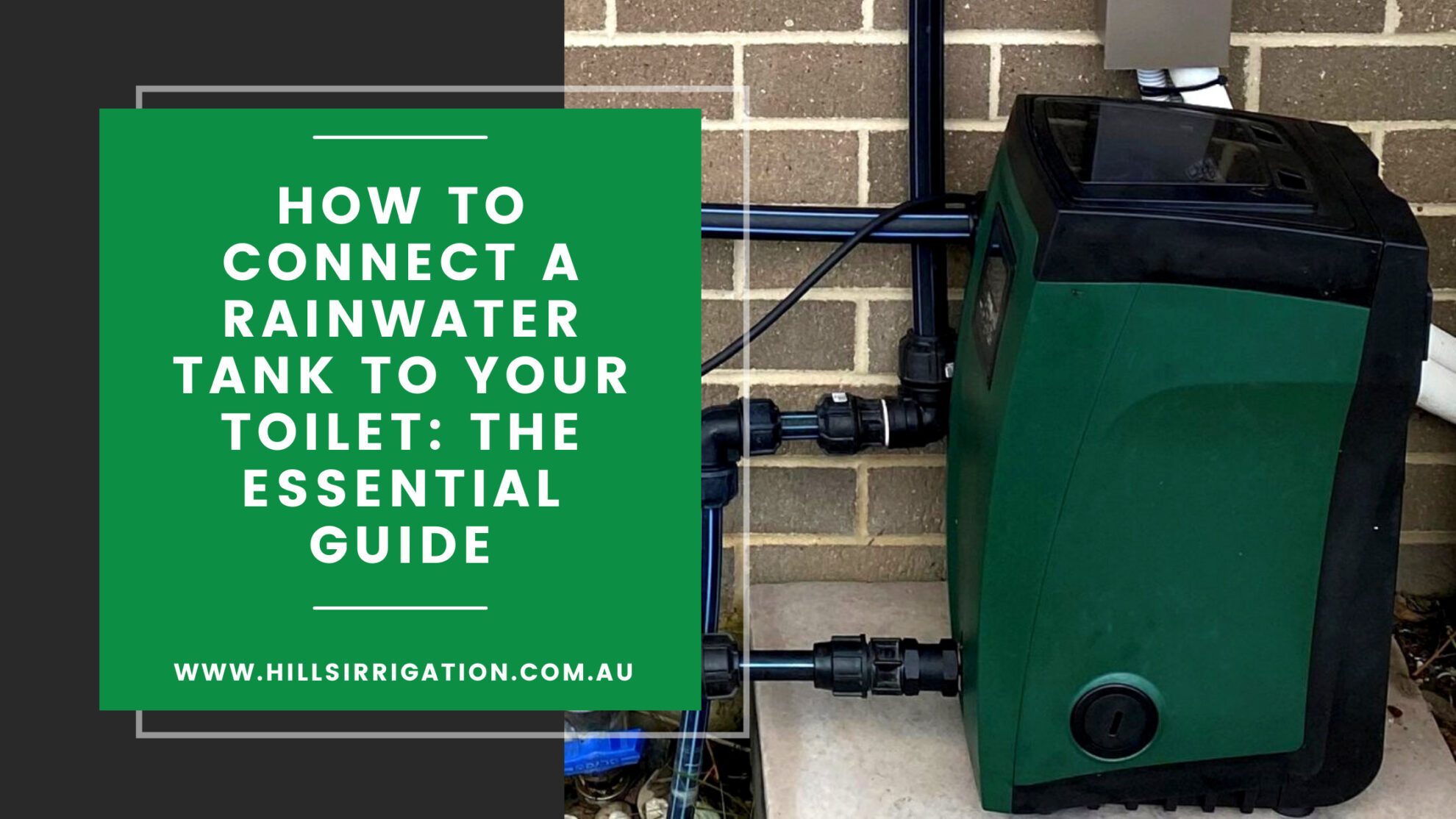
A toilet flush uses up to twelve litres of water. The average person uses thirty litres in the toilet per day. That’s a whole lot of water! But unlike drinking water, water needed for flushing doesn’t need to go through rounds of filtration and treatment. Non-potable water can be used for that purpose.
A rainwater harvesting system is a great way to capture and store rainwater which can then be used for your toilet. Connecting a rainwater tank to your toilet can reduce monthly bills, can save a large amount of water that could be used for other purposes and is much better for the environment. But the question is, how do you do it, and what materials do you need?
When installing a rainwater harvesting system, it should be properly installed and plumbed into your home. If you’re not a skilled plumber, professionals should perform tasks such as connecting the tank to the toilet or laundry. You also need to install flush diverters and filters to avoid water contamination.
The size of the rainwater tank is a key factor as well, and it depends on the function and purpose of the tank. Installing a rainwater tank is relatively simple, and it’s pretty inexpensive. All you need is to get the right materials and equipment and install the harvesting system correctly.
If there was ever anything you wanted to know about connecting a rainwater tank to a toilet, then look no further.
Table of Contents
Can You Use Rainwater To Flush Toilets?
Yes! As we all know, each toilet flush requires a lot of water, and water is one of the most valuable resources. During colonial times, Australian households collected rainwater for this purpose, which is still being practised today.
However, in the last twenty to thirty years, we have made breakthroughs in increasing the structure and efficiency of rainwater collection systems.
The purpose of using rainwater to flush their toilets, for most people, is to save money. Clean drinking water is wasted and expensive when you use it for flushing. To save money and reduce wasting good clean water, more and more people consider collecting and storing rainwater for flushing toilets. From there, it’s a straightforward transition to start using that collected rainwater for other household uses such as laundry washing, dishwashing, and plant watering.
There is a wide variety of rainwater tanks on the market today. The most important factors to consider are space and the volume of water you want to collect, which is why your decision usually revolves around these factors. Prices vary with the tank material and size, with the average starting price at $600 for a 1000 litre tank, which you can install yourself or arrange professional rainwater tank installation.
How Much Water Pressure Does A Toilet Need?
The water pressure required for flushing gravity-fed tank toilets is ten to fifteen psi (pounds per square inch), while pressure-assisted tank toilets need twenty-five to forty psi and above.
The water usage for flushing can vary; a pressure-assisted toilet requires less water, about one to one and a half gallons per flush (GPF).
There are different toilets based on the two basic functions of the toilet (intake of water used for flushing and discharge of wastewater):
- Gravity-fed tank toilets
- Pressure-assisted tank toilets
- Two-button flush toilets
- Wall-hung toilets
- Vacuum-assisted toilets
- Flash valve operated toilets.
Regardless of the type of toilet you have, it requires care and attention to avoid plumbing problems and water wastage.
What Kind Of Rainwater Tank Do I Need To Flush A Toilet?
A 2000L to 3000L rainwater tank is usually sufficient for holding water for toilet flushing and watering a small garden. However, other considerations when choosing the size of your rainwater tank include rainfall patterns, overall water needs, and where the tank will be placed.
In order to collect rainwater, you need to install a rainwater tank. Rainwater tanks come in a variety of sizes, shapes and colours. When buying a tank, you need to consider the location, size, installation, tank materials, water collection, and water use.
You first need to decide where to place the tank; the location will determine its size and shape. Ideally, it should be placed above the ground, which is convenient and straightforward. Also, consider the accessibility for cleaning and maintaining the tank. Installing it next to your house or utility shed makes water collection easier and reduces pipe runs.
If your space is limited, installing the tank underground might solve the issue. However, underground tanks are best installed as your property is constructed or if you’re doing significant groundworks.
The materials of a rainwater tank vary from polyethylene and fibreglass to concrete and steel. Tanks made from polyethylene are durable, UV-resistant, and easy to transport. Fibreglass tanks are tolerant of extreme temperatures and resistant to rust and chemical corrosion. In addition to being durable, concrete tanks can be installed above or below ground and are typically built on-site. Steel tanks can be custom made and are usually made from corrugated or coated steel.
When choosing the size, consider the local rainfall pattern in your area and the average amount of water your household uses.
What Do I Need To Connect A Rainwater Tank To A Toilet?
Some plumbing supplies are needed in order to connect the rainwater tank to the toilet. The exact materials depend on many factors, such as the layout of your home, your existing plumbing network, and more.
You can typically purchase a rainwater harvesting system designed specifically for pumping water from your tank.
Some of the standard equipment used for establishing a connection between the tank and the toilet include:
- A rainwater pump to increase the pressure of the water flow
- A pump pressure controller to monitor the flow of water and regulate the pump accordingly to maintain the desired pressure levels.
- A rainwater to mains switch to give you mains water backup
- Concrete mix for building the foundation of your tank
- A variety of filters to remove debris and impurities in the water
- A flush diverter to divert the first flow of water away from your rainwater catchment system.
- Connections, pipes and fittings to direct the flow of water
- Backflow prevention valve to protect the water supply from contamination via backflow
- Brass ball valves to operate shut-off valves that control water pressure
How To Connect A Rainwater Tank To A Toilet
After deciding the best suitable location for your tank and obtaining all the materials and components needed, the following steps for the installation of the tank are:
- Remove the downpipe from the gutter where the water feeds the rainwater tank.
- Cut and fit to size the downpipes that are connecting to the pump.
- Connect the PVC downpipe from the inlet of the rainwater tank onto the existing downpipe gutter outlet. Use PVC solvent cement on connecting all joins. A 90mm PVC pipe, a couple of bends, and a suitably angled adapter are advisable.
- Attach the first flush diverters or screen guards to the downpipes to remove the solids and prevent tank water contamination.
- Use a 90mm PVC pipe and bending pieces to connect from the rainwater tank overflow outlet into the stormwater system.
- Screw in the brass ball valve at the base of the rainwater tank. Use Teflon plumber’s tape to thread and seal the valve.
- Connect the pump to the ball valve on the tank using the poly pipe and fittings. Let the water flow through the filters used to remove unwanted solids from the water.
- At this point, your rainwater tank is fully operational and can start collecting and using rainwater.
Note that these steps should be carried out by a plumber or other experienced person. By law, connecting a rainwater tank to toilets and washing machines must be done by a licensed plumber.
Your property should have a flat and stable area to support the tank. Round rainwater tanks should be positioned on level, stable ground. Many homeowners choose to place it on a solid concrete slab or a layer of tightly compacted crusher dust.
For information on provisions and regulations for rainwater tank installation, contact your city council. Check first with your local council if approval is required in your area.
Besides the roof, you might also have to check the gutters since this is where water collects and flows. Remove leaves, vegetation, and other debris from the gutters to prevent blockages.
Related Questions:
Can You Use Rainwater for Washing Machines?
Yes, like toilets, washing machines require a lot of water—about fifty litres for every load. As long as rainwater is properly filtered of sediments, you can safely use rainwater to wash your clothes.
Can You Use Mains Water Supply If You Have a Rainwater Tank?
Yes, even if you have your toilet connected to a rainwater tank, you can still go between tank water and mains water supply as you please. You may wish to do this if you are having maintenance performed on your rainwater tank, or if you are having a larger tank installed.
To switch between mains and tank water supplies, you need to have a rainwater to mains switch installed in your system. If you don’t know how to switch from tank water to mains water supply, follow the supplied instructions or speak to your nearest irrigation specialist.
How do you Filter Rainwater?
Filtering rainwater depends on how it is going to be used. If you plan to use it for laundry and toilet flushing, it doesn’t need to go through different treatments. A filter is often sufficient for such a purpose, trapping sediments that could potentially cause clogging.
If you plan to use rainwater for drinking, however, it should undergo a series of treatments. Filtration is not enough as this step only removes solids. The water needs to be treated to kill harmful microorganisms. Different types of filters and treatment systems are used in the rainwater harvesting system, such as mechanical pre-tank filters, microscopic filtration, disinfection, carbon filters, or UV lamps.
Disclaimer:
This article is published for general informational purposes only and does not constitute professional advice. Any action you take upon the information you find on this website is strictly at your own risk. Always ensure you have the right qualifications and certifications to carry out DIY work and never put your safety at risk. Hills Irrigation recommends consulting a professional for all electrical and plumbing work.

Vince is Managing Director of Hills Irrigation and is supported by Lisa in an administrative capacity. Andrew, Isaac and Megan look after the day to day needs of both online and shop customers. As Project Manager, Vince is also responsible for installation projects along with his team. It is his responsibility to work closely with clients to ensure that scope of work is understood and followed.






